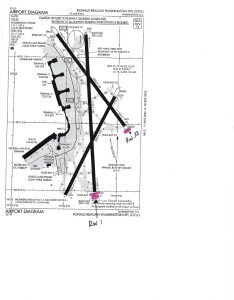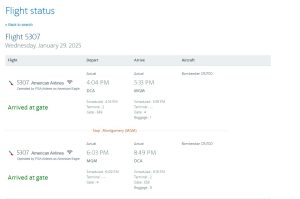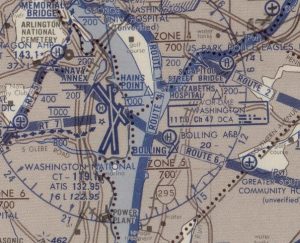The crash of American Airlines Flight 5342 (AA 5342) last night at Washington Reagan National Airport (DCA) has left the nation wondering what happened. Sorting through the details of the events that led to the tragic mid-air collision between a CRJ 700 commercial airplane, and an Army H-60 helicopter will take time and painstaking effort.
We can glean a little information from the Air Traffic Control (ATC) audio communications, however. Broadly speaking, it seems that ATC was handling several aircraft in the immediate airspace around DCA at the time. The longest runway there is Runway 1/19 (which refers to the compass heading of the runway in both directions). You can see a graphic of the DCA runway layout below.

Last night, DCA air traffic controllers were using Runway 1, bringing the planes in to land to the north.
A shorter runway crosses Runway 1 and that is Runway 33/15. Most of the planes last night were landing on Runway 1. One thing that sticks out on audio, however, is that ATC seemed to be trying to reduce traffic on RW 1 and get planes to land on RW 33 instead. One such plane that was asked to do that was American Airlines flight 5307, which was another CRJ 700, also operated by PSA Airlines as American Eagle, just like AA 5342.

AA 5307 landed just about the time of the crash.
AA 5307 was inbound from Montgomery, AL and was asked by ATC if it could land on Runway 33. The pilot of AA 5307 declined, and that flight was then cleared to land on Runway 1. Hear the audio of that exchange here.
Shortly after, AA 5342 checks in with ATC and is asked if it can land on Runway 33. The pilot of AA 5342 agrees and is then cleared to land on Runway 33. Hear that audio exchange here.
Notice at the end of the second audio recording AA 5342 is cleared to land. At that point the airspace is his.
In the meantime, an Army H-60 helicopter appeared to be flying along Helicopter Route 1, which follows the Potomac River from north to south just at the edge of Washington DC. See a graphic of Route 1 below.

News reports indicate that the helicopter was on a training mission and was returning to its base at Fort Belvoir to the south of Washington, DC. What we know at this point is that Helicopter Route 1 takes helicopters right past the approach (landing) end of DCA Runway 33. See graphic above.
We also know that AA 5342, after agreeing to land on Runway 33, was positioned roughly in the vicinity of Helicopter Route 6 on the graphic, preparing to land. The crash happened about where Route 6 and Route 1 cross. But note also that the CRJ aircraft are going to be flying quite a bit faster than the helicopter.
Just prior to the crash, ATC called the helicopter, call sign PAT25, and asked if it had “the CRJ” in sight. The pilot of the Army helicopter confirmed that he did. ATC then told the helicopter to pass behind “the CRJ.” Hear that exchange here.
There appear to be no other radio communications prior to the crash. Interestingly, recall that there were two identical CRJ aircraft landing at roughly the same time. Both were American Eagle flights. AA 5307 was landing on Runway 1 and AA 5342 was landing on Runway 33, about twenty seconds later. We don’t yet know the exact position of all three of the aircraft when ATC called and asked the helicopter if it saw “the CRJ,” but it seems logical in hindsight, that the helicopter may have confirmed seeing AA 5307 and not AA 5342. Given the speed differences, AA 5342 could have been further southeast when the helicopter reported seeing “the CRJ.”
The Washington DC area is filled with lights of all colors and brightness. Airplane lights at that point will have green and red position lights on (as they do all the time), but also the landing lights on. For pilots, it can be very disorienting.
Also, flying past a large airport like DCA can be distracting. Pilots are going to naturally look in that direction first and primarily, as that is where most of the activity appears. Perhaps the helicopter crew saw AA 5307, which would have been lower in altitude and closer to the airfield and failed or forgot to look back to the southeast for other incoming planes.
It should also be noted that ATC only mentioned one CRJ. As has been discussed, there were two. These planes were identical in size and were roughly positioned in the same area. Why didn’t ATC warn that there were two planes in the immediate vicinity of the helicopter? That would have at least put the helicopter on notice that it should be looking in other directions. Of course, the broader question is why were all of these planes crossing courses in the same immediate area, but that will take the investigators much longer to determine.